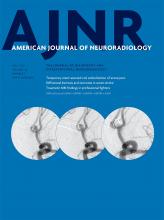Index by author
Wagner, A.
- NeurointerventionYou have accessMechanical Thrombectomy with the Embolus Retriever with Interlinked Cages in Acute Ischemic Stroke: ERIC, the New Boy in the ClassH. Steglich-Arnholm, D. Kondziella, A. Wagner, M.E. Cronqvist, K. Hansen, T.C. Truelsen, L.-H. Krarup, J.L.S. Højgaard, S. Taudorf, H.K. Iversen, D.W. Krieger and M. HoltmannspötterAmerican Journal of Neuroradiology July 2017, 38 (7) 1356-1361; DOI: https://doi.org/10.3174/ajnr.A5201
Wang, W.
- Adult BrainYou have accessNeuroradiologists Compared with Non-Neuroradiologists in the Detection of New Multiple Sclerosis PlaquesW. Wang, J. van Heerden, M.A. Tacey and F. GaillardAmerican Journal of Neuroradiology July 2017, 38 (7) 1323-1327; DOI: https://doi.org/10.3174/ajnr.A5185
Wang, Y.
- EDITOR'S CHOICEAdult BrainOpen AccessThe Use of Noncontrast Quantitative MRI to Detect Gadolinium-Enhancing Multiple Sclerosis Brain Lesions: A Systematic Review and Meta-AnalysisA. Gupta, K. Al-Dasuqi, F. Xia, G. Askin, Y. Zhao, D. Delgado and Y. WangAmerican Journal of Neuroradiology July 2017, 38 (7) 1317-1322; DOI: https://doi.org/10.3174/ajnr.A5209
The authors evaluated 37 journal articles that included 985 patients with MS who had MR imaging in which T1-weighted postcontrast sequences were compared with noncontrast sequences obtained during the same MR imaging examination by using ROI analysis of individual MS lesions. DTI-based fractional anisotropy values were significantly different between enhancing and nonenhancing lesions, with enhancing lesions showing decreased FA. None of the other most frequently studied MR imaging biomarkers (mean diffusivity, magnetization transfer ratio, or ADC) were significantly different between enhancing and nonenhancing lesions. They conclude that noncontrast MR imaging techniques, such as DTI-based FA, can assess MS lesion acuity without gadolinium.
Ware, R.S.
- Pediatric NeuroimagingOpen AccessValidation of an MRI Brain Injury and Growth Scoring System in Very Preterm Infants Scanned at 29- to 35-Week Postmenstrual AgeJ.M. George, S. Fiori, J. Fripp, K. Pannek, J. Bursle, R.X. Moldrich, A. Guzzetta, A. Coulthard, R.S. Ware, S.E. Rose, P.B. Colditz and R.N. BoydAmerican Journal of Neuroradiology July 2017, 38 (7) 1435-1442; DOI: https://doi.org/10.3174/ajnr.A5191
Wiesmann, M.
- EDITOR'S CHOICENeurointerventionYou have accessTemporary Stent-Assisted Coil Embolization as a Treatment Option for Wide-Neck AneurysmsM. Müller, C. Brockmann, S. Afat, O. Nikoubashman, G.A. Schubert, A. Reich, A.E. Othman and M. WiesmannAmerican Journal of Neuroradiology July 2017, 38 (7) 1372-1376; DOI: https://doi.org/10.3174/ajnr.A5204
The authors intended to treat 33 aneurysms between January 2010 and December 2015 with temporary stent-assisted coiling, which formed the series for this study. Incidental and acutely ruptured aneurysms were included. Sufficient occlusion was achieved in 97.1% of the cases. In 94%, the stent could be fully recovered. Complications occurred in 5 patients (14.7%). They conclude that temporary stent-assisted coiling is an effective technique for the treatment of wide-neck aneurysms. Safety is comparable with that of stent-assisted coiling and coiling with balloon remodeling.
Wolf, M.
- NeurointerventionYou have accessCorrelation of Thrombectomy Maneuver Count with Recanalization Success and Clinical Outcome in Patients with Ischemic StrokeF. Seker, J. Pfaff, M. Wolf, P.A. Ringleb, S. Nagel, S. Schönenberger, C. Herweh, M.A. Möhlenbruch, M. Bendszus and M. PhamAmerican Journal of Neuroradiology July 2017, 38 (7) 1368-1371; DOI: https://doi.org/10.3174/ajnr.A5212
Won, H.-J.
- Head and Neck ImagingYou have accessZuckerkandl Tubercle of the Thyroid Gland: Correlations between Findings of Anatomic Dissections and CT ImagingH.-J. Won, H.-S. Won, D.-S. Kwak, J. Jang, S.-L. Jung and I.-B. KimAmerican Journal of Neuroradiology July 2017, 38 (7) 1416-1420; DOI: https://doi.org/10.3174/ajnr.A5172
Won, H.-S.
- Head and Neck ImagingYou have accessZuckerkandl Tubercle of the Thyroid Gland: Correlations between Findings of Anatomic Dissections and CT ImagingH.-J. Won, H.-S. Won, D.-S. Kwak, J. Jang, S.-L. Jung and I.-B. KimAmerican Journal of Neuroradiology July 2017, 38 (7) 1416-1420; DOI: https://doi.org/10.3174/ajnr.A5172
Wu, J.
- FELLOWS' JOURNAL CLUBAdult BrainYou have accessPrevalence of Traumatic Findings on Routine MRI in a Large Cohort of Professional FightersJ.K. Lee, J. Wu, S. Banks, C. Bernick, M.G. Massand, M.T. Modic, P. Ruggieri and S.E. JonesAmerican Journal of Neuroradiology July 2017, 38 (7) 1303-1310; DOI: https://doi.org/10.3174/ajnr.A5175
Conventional 3T MR imaging was used to assess 499 fighters (boxers, mixed martial artists, and martial artists) and 62 controls for nonspecific WM changes, cerebral microhemorrhage, cavum septum pellucidum, and cavum vergae. Fighters had an increased prevalence of cerebral microhemorrhage (4.2% versus 0% for controls), cavum septum pellucidum (53.1% versus 17.7% for controls), and cavum vergae (14.4% versus 0% for controls). This study assessed MR imaging findings in a large cohort demonstrating a significantly increased prevalence of cavum septum pellucidum among fighters. Although cerebral microhemorrhages were higher in fighters than in controls, this finding was not statistically significant.








